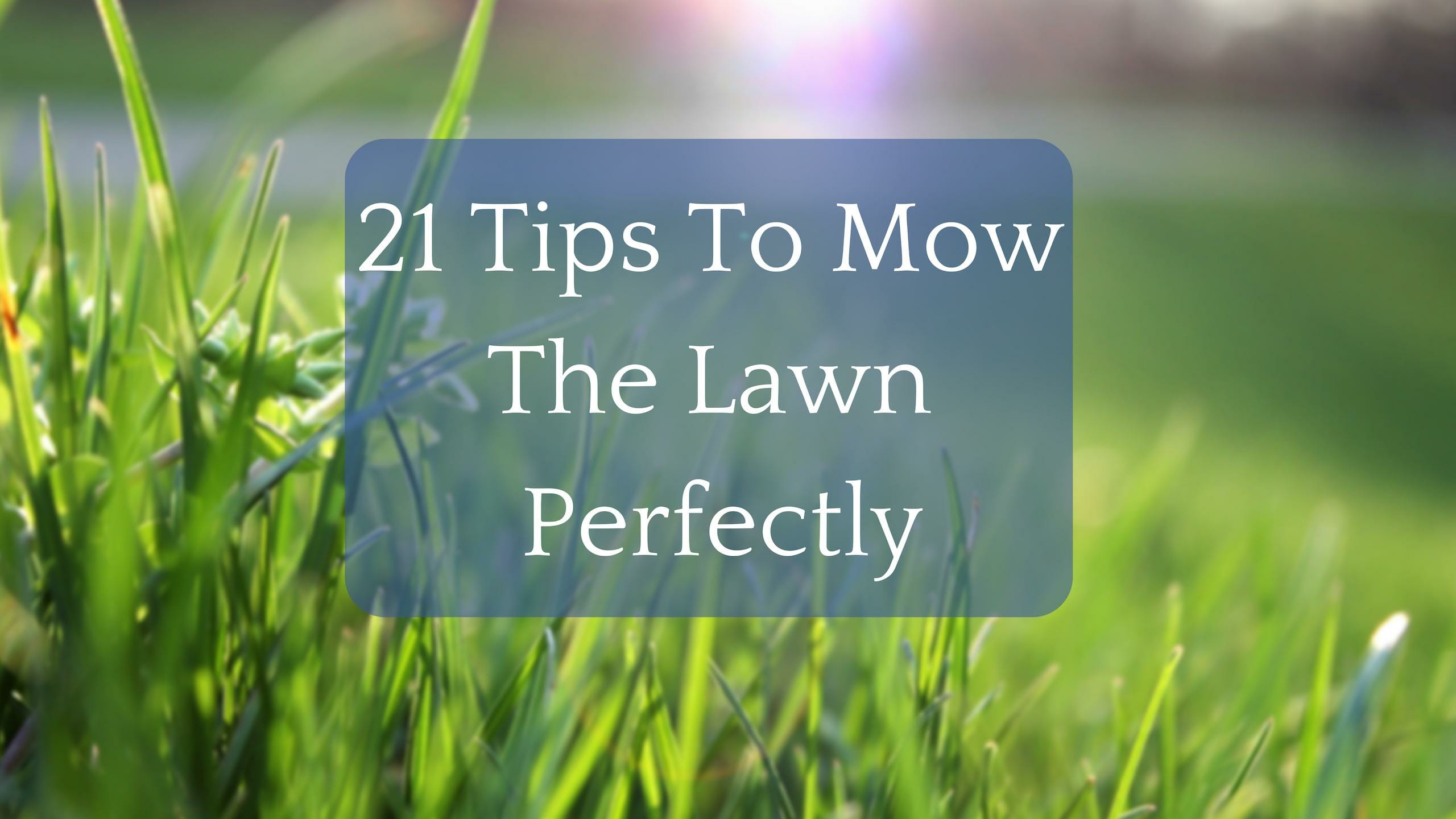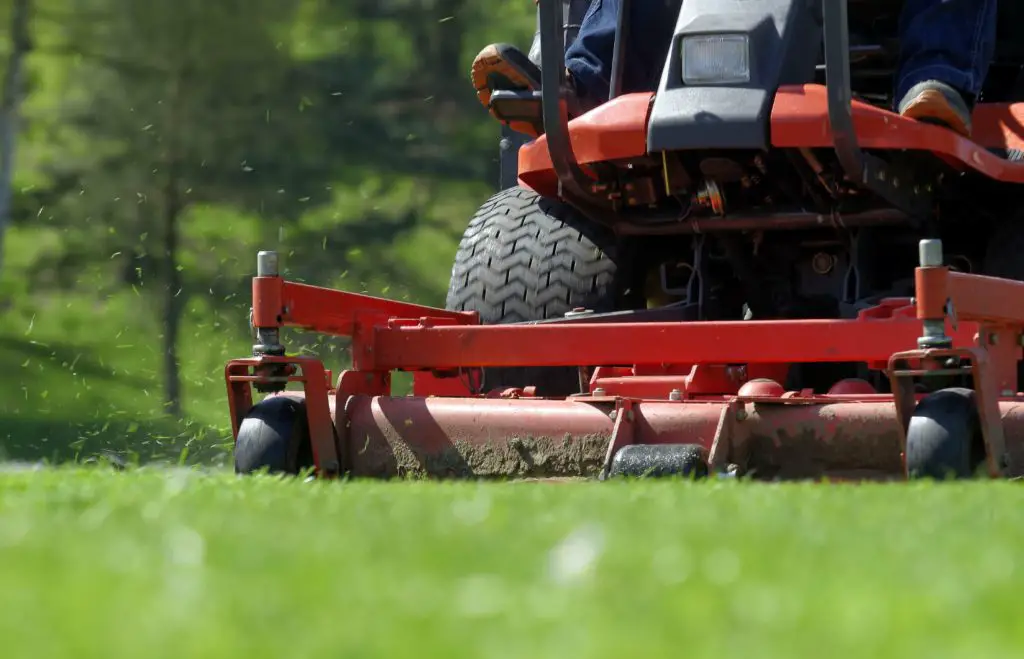21 Handy Tips To Mow The Lawn Perfectly

It’s surprising how fast grass grows; you mowed it the other day, and now it’s time to cut again. Giving up spare hours over a weekend to mow the lawn is rarely fun. There must be a reason why so many gardeners spend two hours or more in the hot sun while others are swimming or sitting in an airconditioned room.
I think it’s the satisfaction afterward, to look back and see a lawn perfectly mowed that makes it worthwhile.
Mowing the lawn is an art that can be broken down into doable steps. When done correctly, the result is a beautiful, healthy lawn with less bare spots and weeds. If you’re new at mowing the lawn or you struggle to mow the lawn correctly, here are 21 tips you may find useful.
1. Get a Robot Lawn Mower
If you hate mowing the lawn, rarely have the free time, or you don’t want to learn how to, get a robot lawn mower. It can easily save you 2 hours a week while it’s quietly mowing the lawn without disturbing the neighbors, even at night.
The robot mower includes a charging station to recharge batteries and a boundary wire. The boundary wire keeps the robot from wandering off. The initial effort of burying the boundary wire is all that’s needed to direct the automatic mower. Clear the lawn of any objects like toys, roots, and hose pipes beforehand. When the robot lawn mower bumps against obstacles, it just steers into a new direction. This may not be the direction you wanted it to mow.
The robot lawnmower is easily controlled from a smartphone and theft is limited with its unique startup pin. The boundary wire keeps the mower on your lawn.
The robot mower can miss a few spots, but it fixes that the next time it’s let loose on the lawn. When mowing small portions at a time, the grass clippings fall between the grass blades and doesn’t stack up on the lawn.
If you’re not ready to spend money on a robot lawn mower yet, or you feel you could mow the lawn better, here are tips on how to do that.
2. Use the Right Lawn Mower
Reel mowers don’t pollute the air and are practically noiseless. It’s low in cost and maintenance. The blades require regular sharpening, and you need to clear the lawn before mowing. It is however physically taxing; without an engine, your muscles supply the power. It is, however, a great choice for small urban plots and for gardeners who enjoy the exercise while mowing the lawn.
Cordless electric mowers are also environmentally friendly because it is battery powered. Batteries require recharging and often take longer than the mowing time a charged battery provides. Having a spare battery solves this dilemma.
For as long as the corded electric mower is plugged in, you can mow. It’s low in maintenance, and the noise level isn’t as high as gas-powered mowers. The length of the electric cord limits the area you can mow, but extension cords may solve this shortcoming.
The third option for an environment-friendly mower is the battery-powered robot lawn mower. It’s as quiet as the reel mower but without the physical strain. It works on any size lawn. To maximize usage of the grass clippings, however, it’s best to set it to cut small sections at a time.
For large lawns, a gas-powered mower may be the option. It has the power to cover large areas, hilly parts, and has no cord or battery that limits it. Gas-powered lawn mower varieties cover most lawn sizes and shapes. The riding and tractor mowers are handy for the very large lawns or for those who aren’t interested in a walk-behind rotary mower. Push-type mowers are the least expensive. Self-propelled lawn mowers are ideal for ¾ acre lawns.

3. Check Fuel and Oil Levels
Before you start mowing, check the fuel and oil levels and top up if low.
If you forgot to check beforehand and started mowing, stop the mower and let the engine cool down. Top up clean oil that is low. If the motor oil is low and dirty, top it up with clean fluid It’s safer to waste some new oil when draining afterward than running out of oil while mowing and damaging the engine.
Fuel and oil are mixed in two-stroke engines. Check that the fuel-oil mixture is the right ratio, and the correct oil is added.
4. Sharpen Lawn Mower Blades
Proper lawn mower maintenance requires checking the blades before mowing the lawn. If blunt, sharpen before you start mowing. Sharpen lawn mower blades at least every two months.
Sharp blades cut grass leaves cleanly and reduce stress. A blunt blade rips the grass forming ragged, brown leaves. The open cut combined with the moisture released from the cutting creates a breeding ground for fungi on the damaged turf.
Mowing the lawn with dull blades will weaken the grass over time. It becomes more susceptible to diseases, insect infestations, and is unable to withstand stress caused by hot and cold weather.
5. Safety Precautions When Mowing
Mowing the yard requires concentration. To avoid unnecessary accidents, don’t mow the lawn when you’re tired.
Always wear protective clothing when mowing the lawn. Cover your legs, arms, and eyes, as a safety precaution against a possible projectile flying out of the chute.
Protect your ears against the noise level. A lawn mower may reach a noise level of 90 decibels. Prolonged exposure to noise levels higher than 85 decibels may cause hearing loss.
Make sure the electric cord is behind you when mowing with an electric lawn mower. Never mow on moist or wet grass with an electric mower.
Ensure the lawnmower blades and other sharp parts of the lawnmower is covered. Make sure the lawn mower is in good working condition before you start mowing.
Avoid accidental cuts from the blades. Wear closed toed shoes. Don’t stick your hands into the mower to remove grass clippings; the blades may still be rotating although the mower is switched off.
6. Regular Mowing is Necessary
If you want a healthy, green, lush lawn, you need to mow it at regular intervals. The effort you put into the yard is almost directly correlated to the end result.
Regular mowing ensures the right grass height needed for aesthetic purposes. It also contributes to the health of the grass. Cutting the grass stimulates new growth in the same manner that pruning a shrub stimulates growth. It nips the new grass shoots that grow from the crown of the grass. New growth spreads and the grass grows thicker developing the lush look you want for the lawn.
7. No Mowing Schedule
For most, part of Saturday is set aside for mowing the lawn. If you want the perfect lawn, stop mowing according to a schedule.
Mow the lawn when the grass needs mowing. Seasons, climate, weather, and the condition of the grass influences grass growth and therefore when the greenery requires mowing. During the grass growing season, you’ll probably mow twice per month. Hot weather needs taller grass and therefore less frequent mowing, while rainy season stimulates grass growth.
Stop mowing the lawn when the grass stops growing. Avoid mowing dormant grass; it’s not necessary.
Remember, the more you mow the lawn, the more you stimulate the grass to grow. That’s why it’s best to mow when it’s needed.
8. Best Time to Mow the Lawn
To prevent injuries and a poorly cut lawn, avoid mowing the lawn when the grass is wet, light is poor, or if you’re tired.
Although mowing the lawn stimulates grass growth, it is stressful to the grass blades. To minimize the stress, mow the lawn mid-morning or early in the evening when the grass is dry.
- If you mow too early, the dew hasn’t evaporated yet.
- Mowing in the heat of the day stresses the lawn, and you’ll suffer from the weather
- Mowing at night when the light is weak, you won’t be able to see well enough to mow the perfect lawn. You’ll end up at best with an uneven cut lawn.

9. Avoid Mowing Wet Grass
If you want the perfect lawn, it’s best to avoid mowing a wet lawn.
- Mowing wet grass is dangerous. Wet grass increases the probability for accidents like slipping on the damp grass close to rotating blades or electrocution if cutting with an electric lawn mower.
- It’s easier to cut dry grass blades evenly than slippery wet grass blades. You’ll end up shredding the grass instead of smooth
- It takes more effort and energy to cut wet grass. Even with sharpened blades, it could be necessary to go over the same patch a few times before you have the desired effect.
- The wet grass clippings that fall between the grass creates the ideal environment for diseases, fungi that cause snow mold, and bacteria growth.
- Wet soil compacts easier which hinders nutrients and air reaching the root system for growth.
- Clumps of wet clippings may stick to the undercarriage and mower blades blocking the mower from working correctly. To prevent the lawn mower working harder than it should, you’ll have to clean the wet grass from it consistently.
- Wet grass may damage the lawn mower when excess water mixes with the remaining fuel. If not properly cleaned, the clippings stuck to the mower may cause mold.
10. Correct Mowing Grass Height
Generally, it’s best to cut the grass during the hot, dry season at the highest setting of the lawnmower blade. Tallgrass prevents the sun baking directly on the soil and helps prevent unnecessary moisture evaporation. Short grass releases moisture faster, which is good if the lawn suffers from snow mold in Spring.
Avoid cutting more than a third of the grass blade length with each cutting. If the grass is too high, don’t be tempted to cut more than a third; rather mow again in a few days. Grass plants with deep roots are healthier, stronger, and have the resistance to survive hot summers and frosted winters. If the grass is cut too close to the crown, it focuses its strength to regrow the grass blades instead of deepening the root system.
11. Lawn Mower Settings for Grass Varieties
Grass heights for cool-season grasses and warm-season grasses differ. Each grass variety has its ideal grass height too that varies from 1-2 inches for warm-season grasses and 3-4 inches for cool-season grasses.
Cool-season grasses should be cut as high as possible. Warm-season grasses, however, should be cut shorter in early Spring to get rid of the dead blades before its growing season.
Lawn more settings for varieties within the grass type may differ. Find out from the supplier what is the perfect grass height for the specific grass.
12. Avoid Scalping the Lawn
Scalping the lawn is when you mow the grass too short.
Grass cut at the correct height is thick and covers the soil. A scalped lawn exposes the soil creating an environment for weeds to grow. Weeds tend to develop where the dirt is exposed. The problem plants receive direct sunlight which enhances their growth.
Traffic on exposed soil creates compact soil. If not loosened, the dense soil will further inhibit grass growth. Nutrients, water, and air can’t seep through hardened soil to reach the roots.
A scalped lawn creates a weak layer of grass because the roots don’t get the opportunity to grow deep. Shallow roots systems don’t have the strength to survive harsh temperatures, diseases or infestations.
13. Mowing New Lawn
Wait before you cut a freshly-seeded lawn. The grass sprouts need to establish themselves. Initial growth focuses on the roots; then nutrients are sent to the grass blades for growth. If you mow too soon, the process is interrupted, and you won’t have a tough grass that will survive diseases and extreme climates.
The first 2-3 weeks are vital for sodded grass to settle its roots into the soil. The new lawn is ready to be mowed if it’s firm enough to walk on. If sod lifts while mowing, gently plant it again. Two inches is the mowing grass height for the first few times you mow the new lawn.
14. Clear the Lawn Before Mowing
Clear the lawn of all potential obstacles before you start mowing. If the lawn mower hits an obstacle like a toy, stones, sticks, dog bones, bottles and cans, it becomes a high-speed projectile. It may cause tremendous harm if it hits a child, adult or pet in the vicinity.
Steer clear of fixed pipes, unmovable rocks, and fixtures by marking the spots beforehand.
To prevent unnecessary injuries, have children and pets stay away from the lawn and its vicinity while you are mowing the grass.
15. Level an Uneven Lawn
Uneven lawns are difficult to mow, may result in scalping the lawn, and may cause injuries during outdoor activities. The mower adjusts its blade height when dipping into uneven parts; the result is lawn scalping of the higher grass when it moves out of the dip.
For a mild unevenness, topdressing made from a mixture of topsoil, compost, and sand should solve the problem. Mow the grass very short to find the problem areas. Rake the lawn to remove thatch before applying the topdressing to the uneven areas.
Limit topdressing to a ½ inch so that grass can grow through it. If the bumpy parts are deeper than the ½ inch, then remove 1-square foot grass sod at a time in areas where it’s too low for the topdressing to work. Add topsoil and water to this area. Then replace the grass sod.
If the unevenness is severe, topdressing and re-sodding after filling the uneven part won’t solve the problem. It requires regrading and the same process as for a new lawn.
16. Mow the Correct Pattern
Mowing the lawn is like a workout; it has a pattern and a specific pace. Cutting in a backward and forward pattern at a brisk pace should give you a neat look you are aiming for.
It’s easier to create neat rows than mowing in a circular pattern. For that perfect lawn, overlap each pass with half the width of the lawnmower. It’s easier to maintain the same movement pattern this way because cutting less grass at a time uses less energy and effort. It also ensures that you overlap any patches you could’ve missed going in the opposite direction.
Avoid cutting the grass always in the same direction by changing the mowing pattern regularly. Grass stands taller if mowed in alternative routes. If you mow the lawn in the same pattern every time, the lawn mower wheels may form grooves in the yard.
17. Mowing Different Lawn Shapes
A square or rectangular lawn is the easiest to shape correctly. Yards, however, are seldom perfectly formed. With skill and strategy, any lawn can be mowed perfectly.
Mowing around the border makes turning easier at each pass. Then mow around flowerbeds and trees and form straight lines and angles. Divide the remainder of the lawn into smaller squares or rectangles to mow.
Mow a slope at a 90-degree angle to the hill instead of up and down. A walk-behind mower may be easier to control on a steep incline.
18. Leave Grass Clippings
Grass clippings are natural fertilizers for the lawn and flower beds. If you mow often, the grass clippings won’t form heaps but will fall onto the soil between the grass plants.
It serves as protection for the soil against heat in summer. It breaks down quickly supplying valuable nutrients for the grass and soil. The clippings aren’t too dense that it blocks air, nutrients, and water from reaching the topsoil and roots.
19. Trimming Edges Before or After Mowing
Decide beforehand if you are going to edge the grass before or after mowing the lawn.
The lawnmower will cut a larger area at a time than a trimmer would. It should save time on trimming the edges afterward. If you’re unsure how close the mower cuts to walls, curbs, and other corners around the garden, it’s best to mow first. Then you can use the string trimmer afterward to trim what the lawn mower missed. It’ll keep you from cutting too much.
If you edge first, however, there is less clean up to do. The clippings fall onto the lawn and are sucked up when the lawn mower cuts over it. Trim long, overgrown fence lines first so that the lawn mower can cut up the larger blades into clippings.
For defining new boundary lines, an edge trimmer would be better to use than a string trimmer. You can use a simple hand-powered one, or pay more for a motor-driven edger. String trimmers work better to maintain the edge.
20. Mowing Speed
Don’t be in a hurry when mowing the lawn. For even lines it’s best to mow at a steady pace and relaxed speed.
It may be tempting to go maximum speed on riding lawn mowers and mower tractors. If you mow too fast, you’ll miss patches and could damage the mower. Four miles per hour should be fine for most lawns. Inspect the terrain and adjust the speed accordingly.
With push-type of lawn mowers make sure you walk at a steady pace to ensure an even cut lawn. Going too fast may cost you more time because you’ll need to go back and fix the rush job. Walk at a pace you can handle without exhausting your body.
You may save time by decreasing the number of turns. If you mow straight lines corresponding with the longest part of the lawn, you’ll make fewer turns.
21. Clean the Lawn Mower Deck
Clean the lawn mower deck at least twice during a season, even if it doesn’t bother you.
The main reason for cleaning the deck is not neatness. The deck covers the mower blades. A a clean lawn mower performs better.
The second reason is a dirty deck may spread disease. When mowing the lawn, the grass is stressed because its blades are cut. These ‘open wounds’ are vulnerable to diseases caused by fungi.
After you’ve disconnected the spark plug and emptied the fuel tank, a hose at full blast will loosen the debris. Then scrub the mower clean with hot water and soap.
When you’ve finished mowing, tidy the lawn by gathering the excess grass clippings you’re not using as mulch.

